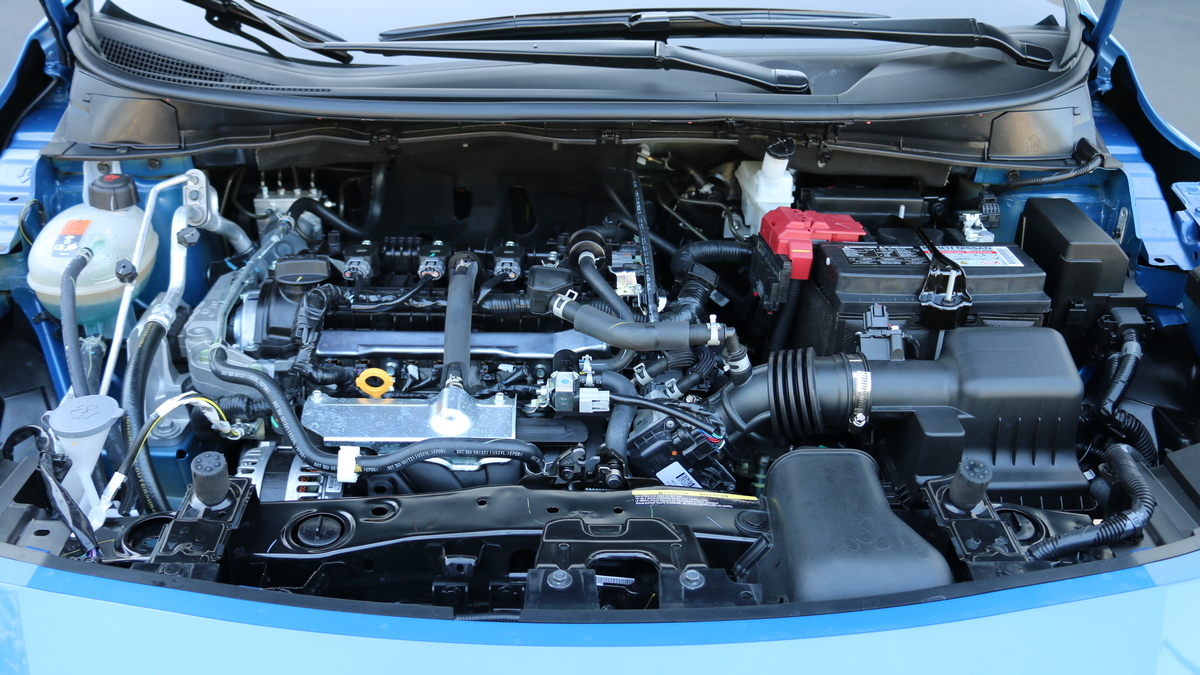Car won’t start because of a dead battery? Don’t worry — we will help you learn how to jump-start a car using clear, step-by-step instructions. Whether this is your first time or you just need a quick refresher, follow along, and we’ll guide you safely through the process. We have detailed information below, including tips and troubleshooting, but let’s get started with the basics.
How to Jump Start a Car
- Park the vehicle with a good battery in front of the one that needs a jump-start. Turn the ignition off and engage the parking brake on both cars.
- Open the hoods on both cars. Locate the batteries and remove the plastic hoods covering the battery terminals, if needed.
- Identify the positive and negative terminals and connect the booster cables:
- First, attach a RED clamp to the positive terminal (+) on the DEAD battery.
- Next, attach the RED clamp from the other end of the cables to the positive terminal (+) on the BOOSTER battery.
- Then, attach the BLACK clamp to the negative terminal (–) on the BOOSTER battery.
- Lastly, attach the BLACK clamp to an unpainted metal part on the engine of the car with the DEAD battery. You can look for a bolt or bracket, although most models have a grounding bolt marked with a (–) placed solely for this purpose.
- Start the engine of the car with the good battery.
- Try to start the vehicle that has the dead battery.
- Disconnect the cables in reverse order and drive for at least 20 minutes while the alternator charges the battery.
This diagram shows the sequence for connecting the cables:
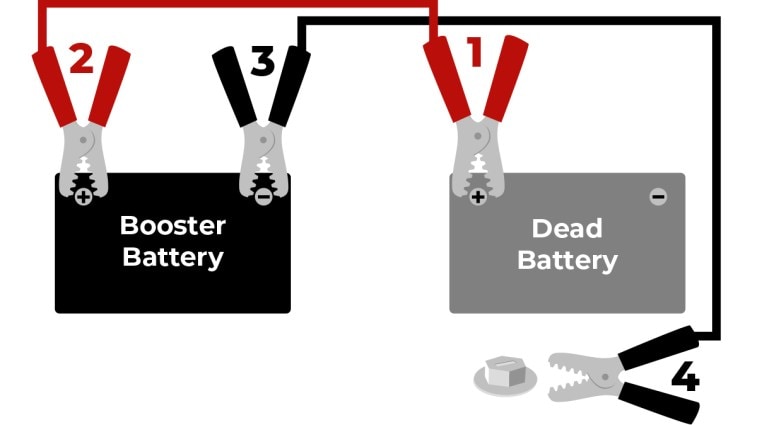
More About Jumping a Car With a Dead Battery
Here are some additional details about the steps to jump-start a car.
Vehicle Position
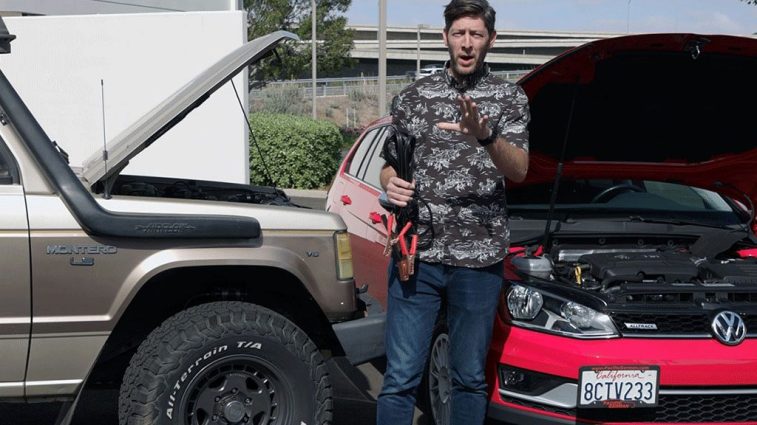
Park the vehicle with a full battery close to the car with the discharged battery. The vehicles can be beside each other or face bumper-to-bumper. They must be close enough to allow the jumper cables to reach both batteries.
Most gasoline-powered vehicles have batteries under the hood. However, in some models, the battery is found in the trunk or under the back seat. Arrange the car with the good battery accordingly. If the battery location isn’t known, check the vehicle’s manual.
Then, shut off the ignition on both cars and remove the keys. Set the parking brake in both vehicles. Turn off all accessories, including climate control, lights, and radio.
Battery Terminals
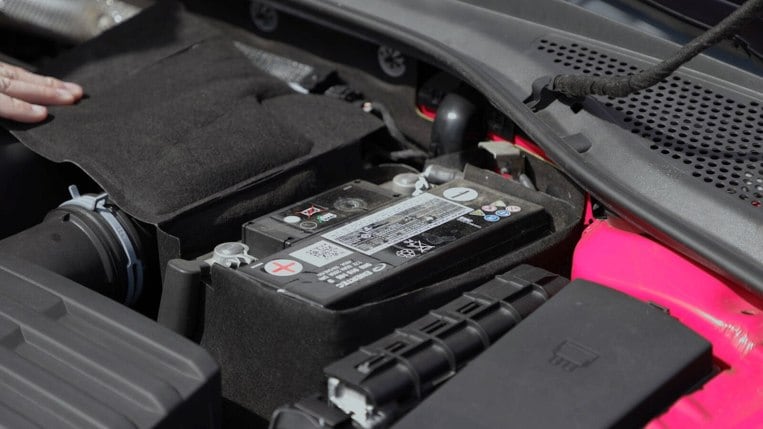
Raise the hoods of the vehicles to access their batteries. A car battery has two terminals — positive (+) and negative (-). Sometimes the battery terminals are hidden, and remote metal posts are placed for convenient access to jump the battery or provide a boost. The positive terminal is often identified with a red cap. Refer to the vehicle manual for terminal locations if necessary.
The terminals should be free from corrosion to ensure good connections with the clamps. If the posts are coated with a white or greenish substance, remove it using a wire brush, aluminum foil, or anything except your bare hand. The corrosion can irritate your skin.
Safety Precaution: Do not attempt to jump-start a battery if it is cracked, leaking, or visibly damaged.
Connecting Jumper Cables
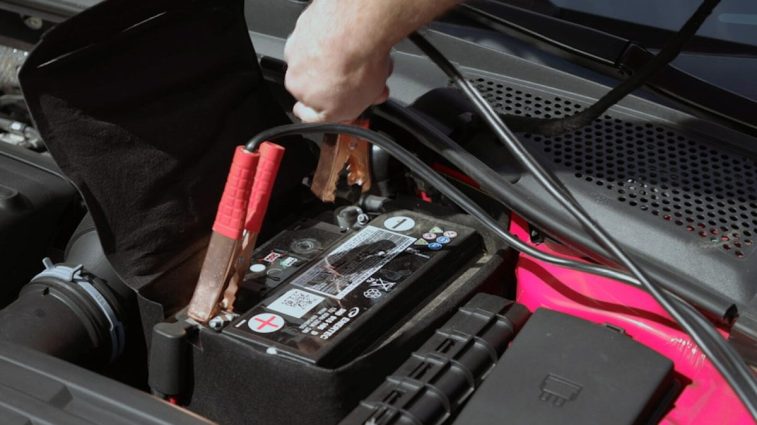
Jumper cables have a pair of spring-loaded clamps at each end — one red and one black. Red clamps attach to positive battery terminals; black clamps are for negative posts or grounding. It’s essential to connect the four clamps securely and in the correct sequence. Improper connection can result in personal injury or damage to the car’s electrical system.
Keep the metal clamps from touching each other while clipping onto the posts in the order described above.
Jump-Starting the Car
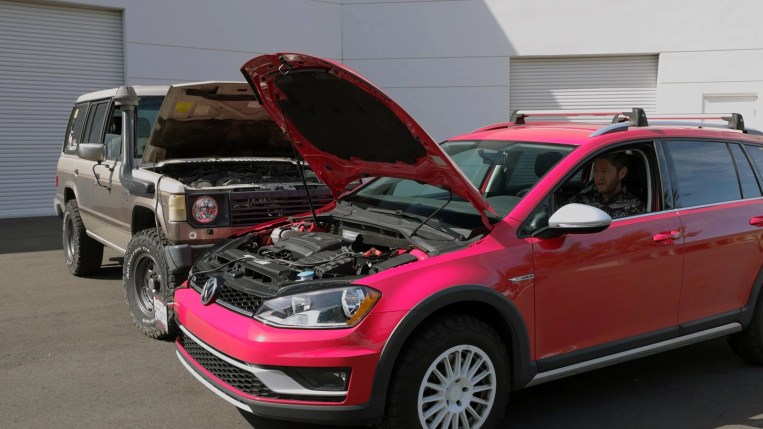
Double-check that the connected booster cables aren’t near moving engine parts before starting the engine of the vehicle that’s donating the electricity.
Then, start the car with the weak battery. If the engine doesn’t turn over right away, you might need to wait a few minutes to allow the battery to build a sufficient charge. Increasing the idle speed of the booster vehicle may help make this happen more quickly.
Note: A dead car battery never gets discovered at a convenient time, and foul weather can add to the inconvenience. If you’re wondering if you can jump a car in the rain, don’t worry — it’s safe. Even with the additional moisture, the vehicle battery’s voltage isn’t high enough to make the task more dangerous than jump-starting on a dry day.
Disconnect Jumper Cables in Correct Order
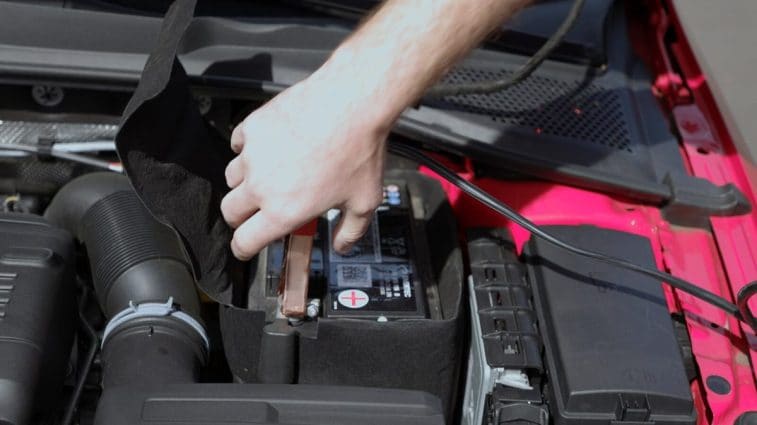
Detach the clamps in the reverse order in which you connected them. Removing the jumper cables in the wrong order might create sparks and lead to an electrical surge that can damage sensitive components or blow fuses. Here’s how to disconnect cables after jumping a car:
- Disconnect the black negative clamp from the jumped car.
- Next, disconnect the black negative clamp from the booster car.
- Then, disconnect the red positive clamp from the booster car.
- Lastly, disconnect and remove the red positive clamp from the jumped car.
Drive the Jumped Car
Keep the jumped car’s engine running as you put away the cables and close the hood. After a 20-minute drive to charge the battery, park in a safe, open area in case another jump is needed. If the car needs another jump, the battery may be failing, especially if it’s a few years old. Many auto parts stores can test your battery to see if it needs replacing.
Troubleshooting and Tips
Keep reading for more information related to jump-starting vehicles.
Car Won’t Jump Start
So, you’ve learned how to jump a car, but what happens if the car won’t start with a boost? Several situations may cause an unsuccessful jump.
- Double-check the booster cable connections and remove corrosion from the battery terminals to ensure good contact.
- Wait a few minutes before trying again. Increasing the booster car’s idle speed may help build a sufficient charge in the car with the weak battery.
- Batteries can fail or be so old and weak that a jump doesn’t help. Replacing the battery might be necessary. A new battery can cost $250 or more.
- If the radio and lights turn on, it means the electrical system is working, and there could be a minor problem with a fuse or the ignition switch, which is a $500 replacement.
- Hearing a clicking sound when trying to jump-start the car may indicate a bad starter that needs replacing. Expect to pay about $750 for a starter replacement at a dealership service center.
RELATED: Why Is My Check Engine Light On?
Choosing Jumper Cables
Using the correct jumper cable order is crucial for getting a boost, and investing in good-quality booster cables can make the job more effective. Look for these characteristics when shopping for a set of reliable jumper cables.
- Thick-gauge wire: The lower the gauge number, the thicker the cable, which has better conductivity. For most vehicles, a 4-gauge or 6-gauge wire is ideal. Avoid 10-gauge cables that can be too thin to handle enough current.
- Copper wiring: Solid copper cables are best. Copper-clad aluminum (CCA) cables are a budget-friendly alternative. Avoid pure aluminum wires, which conduct electricity less efficiently.
- Heavy-duty clamps: For better conductivity, look for fully copper-coated or solid copper clamps. Clamps should be sturdy, with solid teeth and strong springs for a firm grip on battery terminals.
- Clear polarity markings: Red for positive (+) and black for negative (-) markings should be highly visible to avoid connection mistakes.
- Adequate length: Choose longer cables of 16-20 feet in length to give you more flexibility when positioning the vehicles for the jump-start.
- High-quality insulation: Cables should have thick, durable, and flexible insulation made from rubber or PVC to ensure flexibility in cold weather and avoid cracking over time.
- Storage bag: A sturdy carrying bag helps keep the cables organized, protected from damage, and ready when needed.
How Do You Jump a Car When Keyless Entry Doesn’t Work?
A dead car battery might prevent you from using your key fob to unlock the doors remotely. So, how can you pop the hood and jump a car if there isn’t enough juice to undo the power locks? In most cases, the fob contains a hidden physical key to use in emergencies. Still, some vehicles don’t have a visible lock cylinder by the door handle. The key slot may be behind a door handle cover. Techniques for accessing the hidden door lock and using the emergency key vary by make and model. If all else fails, you might require help from a roadside assistance service to open the door and jump-start a car.
MORE: Why Won’t My Car Start?
Can You Jump-Start a Motorcycle With a Car?
Yes, you can, with an asterisk. If you get caught unprepared without a battery charger for your motorcycle, you can safely jump-start a motorcycle battery with a car. The different-sized batteries do not matter. As long as the motorcycle and car batteries use 12 volts and have negative grounding, they will work safely. However, it’s best to use motorcycle jumper cables. With car jumper cables, the larger clamps make it trickier and more difficult to attach safely to a motorcycle. For safety reasons, it’s not wise.
When you’re ready to jump-start a motorcycle with a car, the process works the same way. Follow the directions in your motorcycle manual for hooking up the jumper cables so you don’t create a spark. When your motorcycle battery starts up, go get it checked.
Jumping a Hybrid Car or Electric Vehicle
With the number of electric cars on the road increasing, more people ask if or how you jump a car if it’s a hybrid. The simple answer is that an electric car or hybrid vehicle gets jump-started using a process similar to a traditional gas-powered car.
It’s important to note that hybrids have two batteries: A 12-volt battery — like a traditional car battery — and the more robust setup that powers the electric motor.
Many manufacturers have located their hybrids’ 12-volt auxiliary batteries in unusual places. Some have placed jump-start tabs under the hood in the fuse box for convenience. Because this varies by make and model, it’s best to refer to the vehicle’s owner’s manual for guidance on jump-starting a hybrid.
EVs have a similar situation. A 12-volt battery keeps electronics working while the EV is powered down. If this gets discharged, it could use a jump to get the motor working. You won’t be able to jump-start an EV using a second EV, even if they are the same brand.
The 12-volt system on electric vehicles isn’t designed to provide this kind of service to a second EV.
TIP: Use a gas-powered car or a portable jump-start device when faced with a dead electric car battery.
Bottom Line on How to Jump-Start a Car
Jump-starting a car safely and effectively requires following a 6-step process: Positioning the booster vehicle, securely connecting the jumper cables in the correct order (positive to dead battery, positive to booster, negative to booster, then negative to grounded metal), starting the booster vehicle, and disconnecting the cables in reverse order once the engine runs. After a successful jump, driving the vehicle for at least 20 minutes allows the alternator to recharge the battery.
Editor’s Note: This article has been updated since its initial publication.








